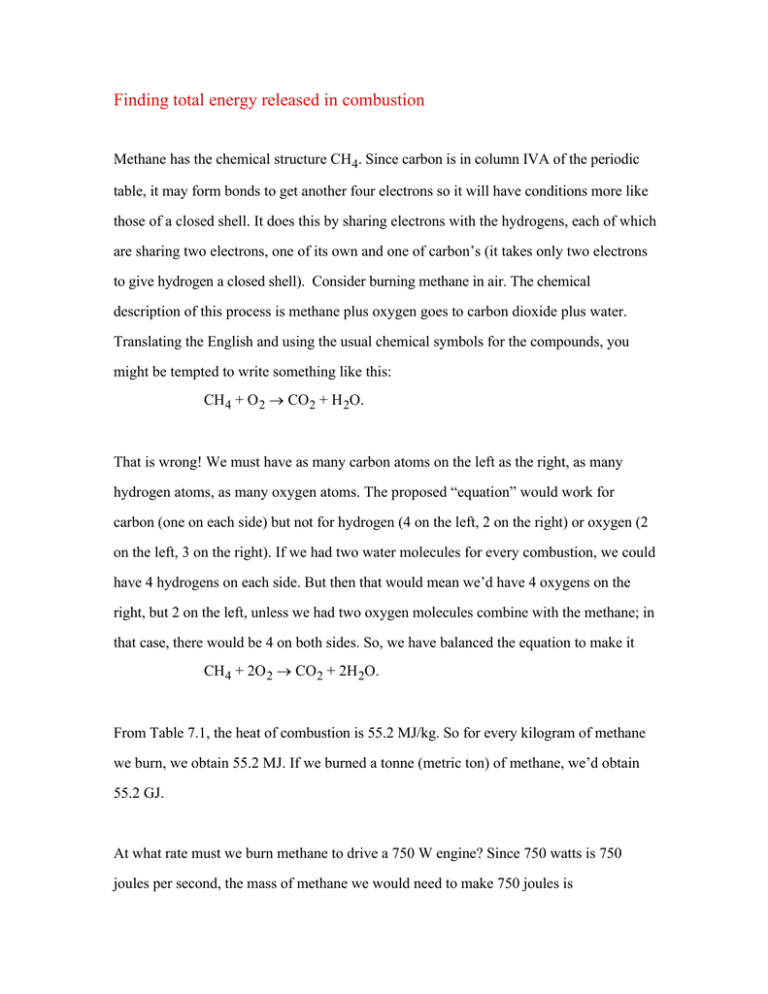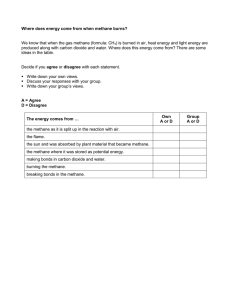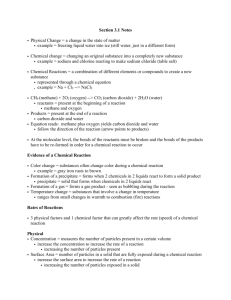Extension 6.1: Finding Total Energy Released in Combustion
advertisement

Finding total energy released in combustion Methane has the chemical structure CH 4. Since carbon is in column IVA of the periodic table, it may form bonds to get another four electrons so it will have conditions more like those of a closed shell. It does this by sharing electrons with the hydrogens, each of which are sharing two electrons, one of its own and one of carbon’s (it takes only two electrons to give hydrogen a closed shell). Consider burning methane in air. The chemical description of this process is methane plus oxygen goes to carbon dioxide plus water. Translating the English and using the usual chemical symbols for the compounds, you might be tempted to write something like this: CH4 + O 2 → CO2 + H 2O. That is wrong! We must have as many carbon atoms on the left as the right, as many hydrogen atoms, as many oxygen atoms. The proposed “equation” would work for carbon (one on each side) but not for hydrogen (4 on the left, 2 on the right) or oxygen (2 on the left, 3 on the right). If we had two water molecules for every combustion, we could have 4 hydrogens on each side. But then that would mean we’d have 4 oxygens on the right, but 2 on the left, unless we had two oxygen molecules combine with the methane; in that case, there would be 4 on both sides. So, we have balanced the equation to make it CH4 + 2O 2 → CO2 + 2H 2O. From Table 7.1, the heat of combustion is 55.2 MJ/kg. So for every kilogram of methane we burn, we obtain 55.2 MJ. If we burned a tonne (metric ton) of methane, we’d obtain 55.2 GJ. At what rate must we burn methane to drive a 750 W engine? Since 750 watts is 750 joules per second, the mass of methane we would need to make 750 joules is Energy, Ch. 6, extension 1 Finding total energy released in combustion 750 J/(55.2 MJ/kg) = 1.36 x 10-5 kg. Since we need this 750 joules every second to make 750 watts, we would need to burn methane at a rate of 1.36 x 10-5 kg/s, or 0.82 g/min or 48.9 g/h or 1.17 kg/d. This is not very much fuel needed because the heat of combustion is so high. Note the consequence from the chemical equation. For every fixed amount of carbon burned, a fixed amount of carbon dioxide is produced. If we burn a kilogram of methane, we use the Periodic Table of Fig. 6.4 to see the molecular mass is about 12 + 4 = 16 atomic mass units, three-quarters of which is carbon. We would have 0.75 kg of carbon in the methane. In carbon dioxide, each carbon combines with two oxygens, and again from Fig. 6.4, we see that the molecular mass will be about 12 + 2 x 16 = 44 atomic mass units. So the mass of the carbon dioxide given off will be 44/12 times the mass of the carbon, which is 3/4 the mass of the methane. The result is that burning one kilogram of methane releases 44/12 x 3/4 x 1 kg = 2.75 kg of carbon dioxide. Let’s contrast this with burning pine. Wood is roughly made of carbon in the compound lignin, and has a chemical formula C6H11O5. If we burn wood, we combine wood with oxygen and make carbon dioxide and water, as before. A little thought will show that the balanced equation must be 4C6H11O5 + 25O 2 → 24CO2 + 22H 2O. There are 24 carbons on each side, 44 hydrogens, and 70 oxygens. Again using the Periodic Table (Fig. 6.4), we see that burning one kilogram of wood burns 12 x 24/(12 x 24 + 44 x 1 + 20 x 16) kg = 0.442 kg of carbon. Since each carbon still produces 44/12 as much carbon dioxide, it will produce 44/12 x 0.44 kg = 1.62 kg 2 Energy, Ch. 6, extension 1 Finding total energy released in combustion of carbon dioxide. Hm. So it’s better to burn wood, because it produces less carbon dioxide? However, remember that because the heat of combustion is lower, the burning of 1 kilogram of pine wood produces only 18.5 MJ, according to Table 7.1. This is far less than the 55.2 MJ produced by burning the methane. If we find out how much carbon dioxide is produced per joule, it is 2.75 kg/55.2 MJ = 49.9 x 10-3 kg/MJ = 49.9 g/MJ, while pine wood gives off 1.62 kg/18.5 MJ = 87.5 x 10-3 kg/MJ = 87.5 g/MJ. From the point of view of reducing the emission of carbon dioxide, methane is almost twice as good as wood. 3





